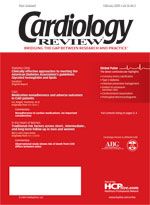A roundup of breaking cardiac news
Many physicians should change their pain relief recommendations for patients with chronic pain who also have or are at risk for heart disease, according to a new scientific statement released by the American Heart Association (AHA).
“First, do no harm” moves COX-2 inhibitors to last line of treatment
“We believe that some physicians have been prescribing the new cyclooxygenase (COX-2) inhibitors as the first line of treatment,” says Elliott M. Antman, MD, lead author of the AHA statement and Professor of Medicine at Harvard Medical School and Brigham and Women's Hospital. Instead of this approach, the new AHA guidelines emphasize a gradual approach to therapy that begins with nonpharmacological efforts, moves to less risky drugs first, and only moves to COX-2 inhibitors with careful consideration of risks and benefits.
Since the last AHA recommendations on this topic in April 2005, additional cautionary information on various pain relief medications has emerged. A meta-analysis discussed in the new statement indicates that, compared with placebo, COX-2 selective drugs seem to increase the risk of a heart attack by about 86%. The statement also points out that 2 common nonsteroidal anti-inflammatory drugs (NSAIDs) traditionally thought of as nonselective—diclofenac and ibuprofen—appear to increase the relative risk of cardiovascular disease (CVD). One nonselective NSAID, naproxen, did not seem to increase CVD risk in these analyses. Although naproxen appeared safer than the other NSAIDs, Antman cautions that relatively few studies have been done with naproxen and doctors should continue to be cautious about prescribing it as well, pending more information. In the last 2 years, the US Food and Drug Administration added warning statements to NSAIDs other than aspirin, pointing out the increased risk for cardiovascular events.
“This is a fast-moving field with new information available from multiple sources,” notes Antman. With that in mind, Antman says, this scientific statement is intended “to give practical advice to clinicians who treat cardiac patients with pain every day.”
The advice is helpfully condensed into a single figure outlining a stepped-care approach to pharmacologic therapy. Before that point is reached, however, the emphasis is on a non­pharmacological approach.
“We advise physicians to start with nonpharmacologic treatments such as physical therapy and exercise, weight loss to reduce stress on joints, and heat or cold therapy,” says Antman. “If the nonpharmacologic approach does not provide enough pain relief or control of symptoms, we recommend a stepped-care approach when it comes to prescribing drugs,” he adds. Physicians should “take into account the patient's health history and consider acetaminophen, aspirin, and even short-term use of narcotic analgesics as the first step,” the statement continues. If this is insufficient, “physicians should suggest the least selective COX-2 inhibitors first, moving progressively toward more selective COX-2 inhibitors, which are at the bottom of the list, only if needed. All drugs should be used at the lowest dose necessary to control symptoms and prescribed for the shortest time possible.”
This care with drug therapy is important, cautions Antman, since there are so many drugs in the NSAID class and because they can affect either COX-1 or COX-2 or both. The statement contains guidance that helps doctors see where individual drugs lie on the continuum of COX-1 versus COX-2 selectivity, a useful tool when evaluating the results of head-to-head comparisons of different drugs.
The complete scientific statement can be found at (
.
www.circ.ahajournals.org/cgi/reprint/CIRCULATIONAHA.106.181424)
An ongoing observational study may provide answers as to whether a wireless home monitoring system for patients with implanted defibrillators can provide more up-to-the-minute care while also decreasing hospitalizations for heart failure.
Home monitoring of defibrillator patients: better care and lower costs?
The LATITUDE Patient Management System (Guidant/Boston Scientific, Natick, Mass) was approved by the Food and Drug Administration (FDA) in September 2005. It consists of a wireless-enabled implantable defibrillator, an in-home monitor that reads information from the implanted device, a secure website to store and archive data transmitted from individual devices, and a wireless programming tool for physicians to use with the device.
According to the manufacturer, physicians can remotely monitor daily or weekly changes in health information, resulting in fewer office visits. An optional and separately priced component will also allow physicians to wirelessly monitor changes in weight and blood pressure, key elements in successfully managing heart failure.
Following the FDA approval, the observational pilot study began enrolling patients in May 2006, and is taking place in 18 centers around the country. Investigators plan to enroll 1000 patients in total, and the study is expected to be completed in 2008. Investigators will create an algorithm to estimate hospital use drawing on data from the device (ie, activity log, heart rate variability, arrythmias, therapy history, lead parameters), weight and blood pressure data from the additional component, and patient questionnaires.
According to Dr Kousik Krishnan, principal investigator of the study at Rush University Medical Center, Chicago, Illinois, “with patient information available weekly, or even daily if needed, we can better monitor our patients. We can pick up abnormalities sooner and act on those before they become serious.”
